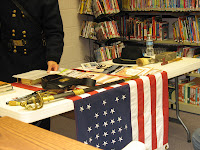 The Friends of the Library monthly Hot Reads series presented Micheal Eckers, local author and historian. Eckers came dressed as General Sibley and related events that led up to the 1862 Dakota Conflict along the Minnesota River.
The Friends of the Library monthly Hot Reads series presented Micheal Eckers, local author and historian. Eckers came dressed as General Sibley and related events that led up to the 1862 Dakota Conflict along the Minnesota River.
37 people attended this event at the library as Eckers compared and contrasted both sides of this conflict. The audience learned that because so many men left to fight in the Civil War the women, old men and children were very vulnerable during the summer of 1862. The Dakota Indians realized this was their only chance to get back their land that was stolen the previous year. Atrocities were committed by both the Indians and the white men. Not all of the Dakota Nation was at war with the settlers, a large group of "friendlies" protected the settlers from the being killed during the conflict. The end of the Dakota War resulted in the largest mass execution of Indians (38) Indians being hanged in Mankato.

Eckers shared some of the weapons used in the conflict.
Powder horn used by the Indians to load their guns no lead just gravel to shoot at the settlers.




No comments:
Post a Comment